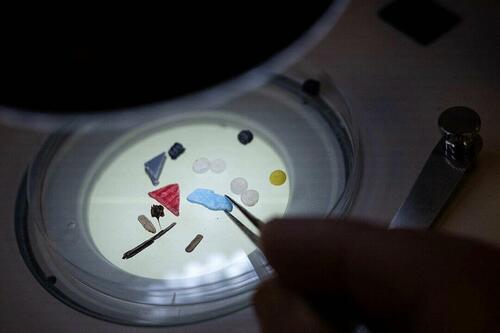Scientists Discover Toxic Microplastics In Every Human Placenta Tested In Study
Authored by Naveen Athrappully via The Epoch Times (emphasis ours),
Harmful microplastics have been found in human placenta, with some of them known to trigger asthma, damage the liver, cause cancer, and impair reproductive function.
The peer-reviewed study, published in the Toxicological Sciences journal on Feb. 17, examined the issue of nano- and microplastic (NMP) pollution in human beings. Researchers found that all 62 tested placenta samples contained microplastics, with concentrations ranging from 6.5 to 790 micrograms per gram of tissue. The placenta is an organ that develops in the uterus during pregnancy. It provides oxygen and nutrients to the baby while also removing waste products from the child’s blood.
The most prevalent microplastic found in the samples was polyethylene, which accounted for 54 percent of all detected NMPs and was “consistently found in nearly all samples.”
Polyethylene has been associated with several health complications like asthma, hormone disruption impacting reproduction, and mild dermatitis or swelling and irritation of the skin.
Polyvinyl chloride (PVC) and nylon each represented approximately 10 percent of the NMPs by weight. PVC has been linked to damage to the liver and reproductive system. The substance is carcinogenic. While nylon itself is seen as harmless, the material undergoes chemical treatments during the manufacturing processes that can pose health risks.
The remaining 26 percent of microplastics found in the 62 tested placenta were represented by nine other polymers. Matthew Campen, Professor in the UNM Department of Pharmaceutical Sciences, who led the team that conducted the study, expressed concerns about the steadily rising presence of microplastics and its potential health implications.
While plastics themselves have traditionally been seen to be biologically inert, microplastics are so small they can cross cell membranes, he noted. Mr. Campen found the concentration of microplastics in the placenta troubling as the tissue was only eight months old when tested. “Other organs of your body are accumulating over much longer periods of time,” he said.
Mr. Campen believes the accumulation of microplastics in human tissue could explain the puzzling rise in certain health problems like colon cancer among people younger than 50, inflammatory bowel disease, and decreasing sperm counts.
“It’s only getting worse, and the trajectory is it will double every 10 to 15 years,” he said. “So, even if we were to stop it today, in 2050 there will be three times as much plastic in the background as there is now. And we’re not going to stop it today.”
Talking about the rising volume of microplastics in the environment, Mr. Campen said that “if we’re seeing effects on placentas, then all mammalian life on this planet could be impacted. That’s not good.”
Microplastic Effects
The presence of microplastics in placentas was first identified in 2020 in a study from Italy. Researchers analyzed six placentas and identified 12 microplastic fragments in four of them. “Microplastics were found in all placental portions: maternal, fetal, and amniochorial membranes,” it said.
“Microplastics carry with them substances which acting as endocrine disruptors could cause long-term effects on human health.”
In 2022, microplastics were discovered in the lungs of a living human being for the first time. Out of the 13 lung samples, 11 had the presence of 39 microplastics. Researchers identified 12 types of microplastics commonly found in bottles, packaging, clothing, and rope.
A recently published study found microplastics in the majority of protein foods like chicken, pork, seafood, beef, and plant-based meat alternatives. The foods sampled in the study included processed, unprocessed, and minimally processed items.
Roughly half the identified microplastics were fibers, which researchers said was consistent with other studies. Almost a third of the microplastics were plastic fragments.
A 2023 study on mice found that three-week exposure to microplastics resulted in “behavioral changes as well as alterations in immune markers in liver and brain tissues. Additionally, we noted that these changes differed depending on age, indicating a possible age-dependent effect.”
Another study conducted in mice found that nanometer-sized particles reached the brains of the animals just two hours after being exposed. A third study found that inhaled microplastic and nanoplastic particles can “alter inflammatory, cardiovascular, and endocrine activity.”
Microplastics have also been found in breast milk. Researchers of the study called the finding a “great concern” given that nanoparticles have also been discovered in human placenta.
“In fact, the chemicals possibly contained in foods, beverages, and personal care products consumed by breastfeeding mothers may be transferred to the offspring, potentially exerting a toxic effect,” they wrote.
“Hence, it is mandatory to increase efforts in scientific research to deepen the knowledge of the potential health impairment caused by MP (microplastics) internalisation and accumulation, especially in infants, and to assess innovative, useful ways to reduce exposure to these contaminants during pregnancy and lactation.”
Since the 1950s, plastic use globally has grown exponentially, leading to the generation of a metric ton of plastic waste for every individual in the world. Roughly a third of the plastic that has been produced is still in use, with much of the remaining discarded or sent to landfills where they start to break down.
Mr. Campen pointed out that many plastics have a long half-life, which refers to the time required for half a sample to degrade.
“So, the half-life of some things is 300 years and the half-life of others is 50 years, but between now and 300 years some of that plastic gets degraded. Those microplastics that we’re seeing in the environment are probably 40 or 50 years old,” he said.
Tyler Durden
Sat, 03/09/2024 – 14:00
via ZeroHedge News https://ift.tt/kgTlBin Tyler Durden
